Hamster cages, besides being suitable for Syrian hamsters, can also be used for hedgehogs and other small rodents. Below are the advantages and disadvantages of each type and a selection guide. It is crucial to avoid traditional metal wire cages, as they can injure the feet and there have been cases of hamsters getting trapped and dying… Please take note.
Four Common Types of Cages and Their Pros and Cons
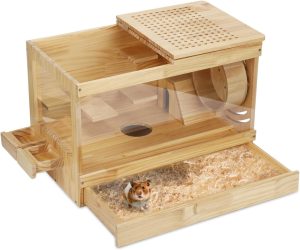
Source:Amzaon
Wooden Aesthetic Cage
Recently, stylish hamster cages have become popular; they also serve as attractive furniture pieces. Some cages feature easy-to-clean trays or designs that allow for exploration and climbing, catering to various buyer modifications. Although generally more expensive, they are still cheaper than cat and dog supplies. These seem to be relatively rare.
Advantages: Natural and high-quality texture; highly aesthetic and functional.
Disadvantages: If the wood is not properly treated or is exposed to a humid environment for a long time, it may become damp and could be relatively heavy.
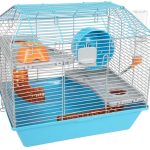
Source:Wayfair Tucker Murphy Pet™
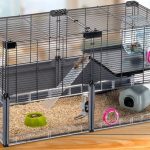
Source:Amazon FERPLAST
Metal Wire Cage
Traditional and commonly seen cages used for birds, turtles, cats, and dogs. However, it’s strongly advised not to use them anymore. Besides negatively affecting the feet, hamsters may chew on them as grinding material, unknowingly ingesting paint, rust, and other substances. The Hamster Lovers Association does not recommend using such cages, primarily because there have been cases of hamsters getting trapped and dying in the wire. Even if some look nice and have flat bottoms, it’s better to avoid using them.
Advantages: Inexpensive, well-ventilated, and most convenient for adding accessories.
Disadvantages: Potential hazards and safety issues.
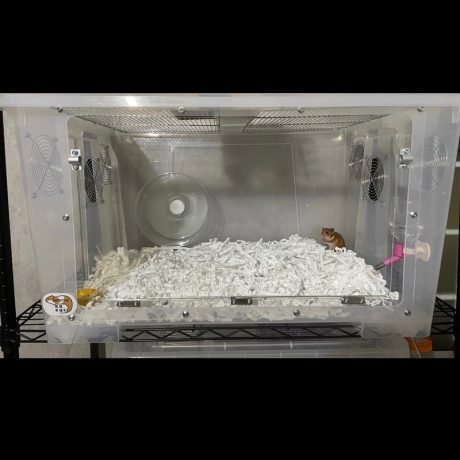
Source:Shopee
Storage Box
Nowadays, many people modify IKEA storage boxes; they are simple and easy to clean. Traditional transparent plastic enclosures are less used due to cleaning difficulties and poor ventilation. Additionally, if the plastic is chewed, it needs to be replaced.
Advantages: Easy to transport (storage boxes have handles), easy to clean, and inexpensive.
Disadvantages: After all, it’s a storage box; modifications (such as ventilation holes, reserved slots for wheels/water dispensers, etc.) are not easy. Syrian hamsters with strong destructive power may chew through it.
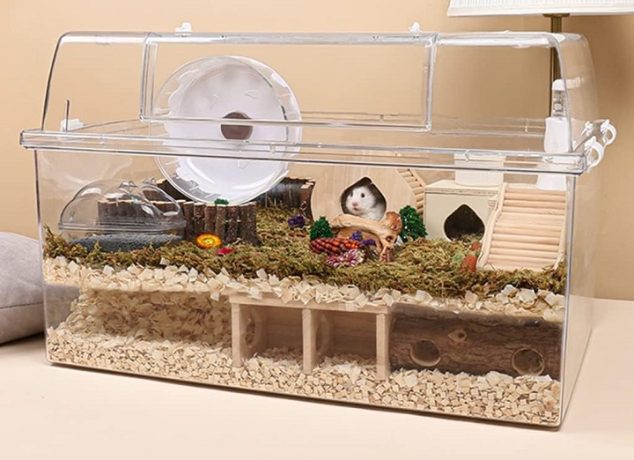
Source:Amazon MGCtech
Transparent Aquarium-style Hamster Cage
Composed of transparent glass or acrylic on all sides, currently less commonly used. In fact, many are IKEA storage boxes fitted with transparent acrylic panels, combining practicality with transparent visibility.
Advantages: Broad field of view and good insulation.
Disadvantages: May be relatively heavy and not easy to modify; attention needs to be paid to ventilation performance.
How to Choose a Suitable Hamster Cage?
Cage Size
It’s generally recommended that the cage base be at least 60×30 cm, with a height of at least 30 cm. Hamsters are active animals (though dwarf hamsters like pudding hamsters tend to be lazier), and they need space for essentials such as a wheel, water bottle, and hideout.
Ventilation
The upper part of the cage should have at least one pair of ventilation holes, such as a mesh top or a PC fan vent, to ensure airflow throughout the cage. Alternatively, an open-top design can also help — but be cautious: hamsters are excellent climbers and may escape by climbing on the wheel or other objects.
Ease of Cleaning
Hamster cages should be cleaned at least once a week. Some cages are difficult to clean or prone to dirt buildup, while others have a removable base tray for easier maintenance. During cleaning, place your hamster in a temporary travel cage and return them once the main cage is clean and dry.
Safety and Escape Prevention
Hamsters love to chew and burrow, so in addition to material durability, check for overall cage safety:
Avoid wire cages with wide gaps — some hamsters chew and squeeze their way out, risking injury or death.
Poorly designed wheels may trap the hamster between the support and the wheel.
Watch for sharp edges or poorly constructed joints that may cause harm.
As for escape prevention, consider the following:
Can the cage material be chewed through?
Are the latches secure enough to prevent your hamster from opening them?
If the cage has no top cover, ensure that the height between the top of the wheel or hideout and the cage edge is at least twice the length of your hamster’s body to prevent climbing out.
Placement and Environment
Finally, place the cage in a warm, quiet area away from direct sunlight. Also, be mindful of pests — avoid placing the cage near areas where cockroaches, centipedes, or other unwanted creatures may appear.